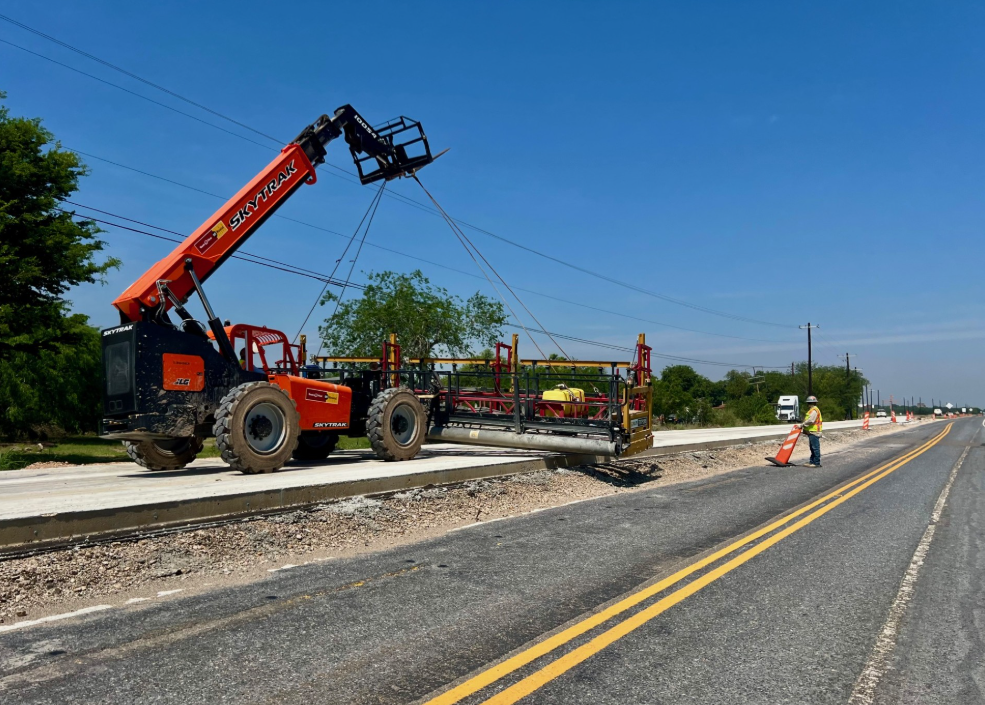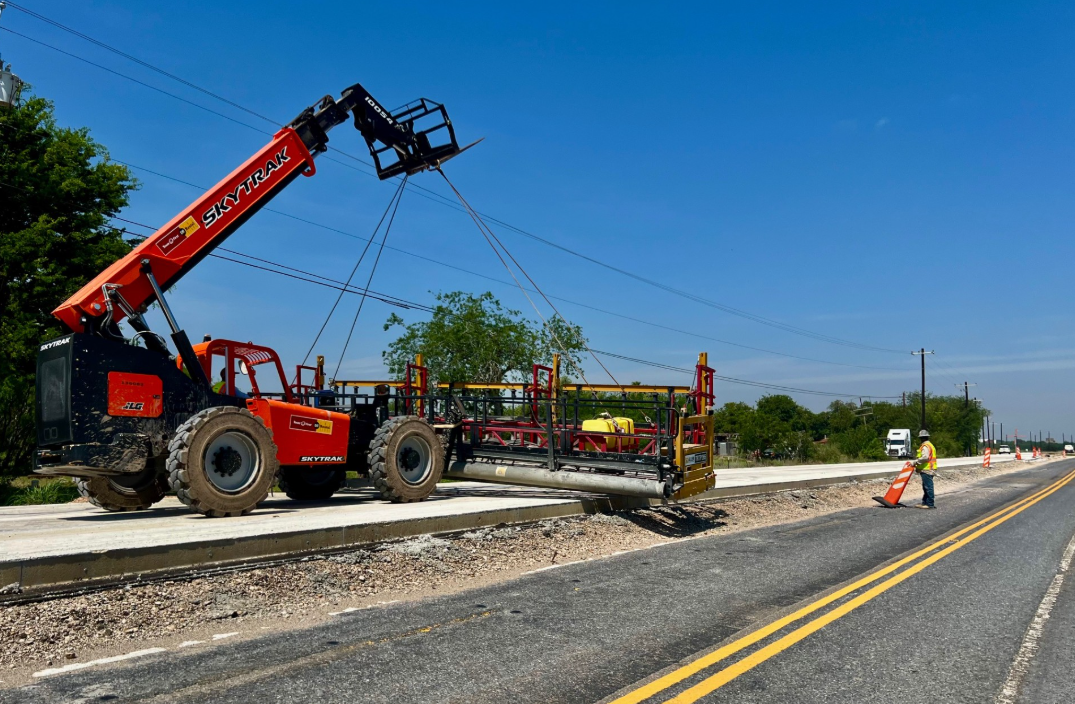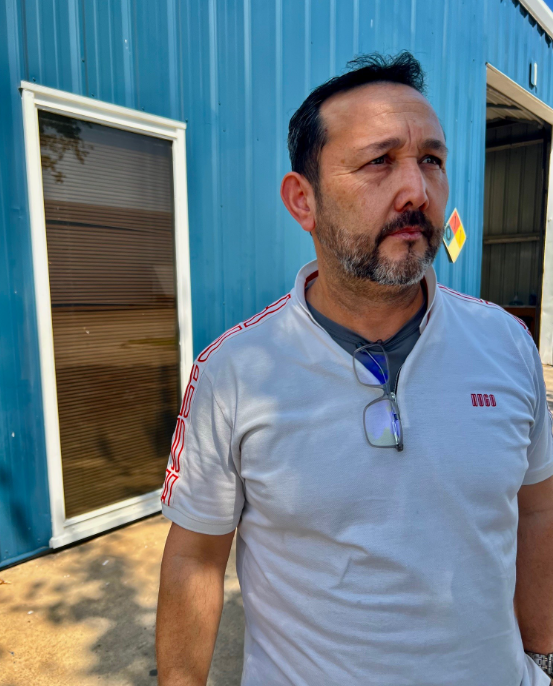Building the border’s future amid tariff uncertainties

By Alfredo Corchado, Eduardo Garcia and Angela Kocherga
Story edited by Dudley Althaus
Photos by Omar Ornelas, Michael Gonzalez, Alfredo Corchado This story was co-published with Puente News Collaborative, a bilingual nonprofit newsroom, convener and funder dedicated to high-quality, fact-based news and information from the U.S.-Mexico border.
ANZALDUAS INTERNATIONAL BRIDGE (OR MISSION,) TEXAS – Even as President Trump was vowing hellfire for the trade that has forged the U.S.-Mexico border into a business beehive, crews proceeded laying cement for yet another road to channel foreign cargo crossing her to deep into the American heartland.

Much of the new road will run atop levees built long ago to tame the once-menacing border stream. It’s but the latest to be thrown up along the entire border since free trade with Mexico became law three decades ago.
“You can’t roll history back,” says Sam Vale, owner of another bridge, some 40 miles upriver from Anzalduas, one of only two privately owned along the border.
“In the end it comes down to profit and free trade has been profitable,” the 82-year old Vale says. “This economic engine will continue. It will never, ever be stopped.”

Analysts and officials say Mexico and Canada largely emerged solid from the sweeping tariffs that Trump announced Wednesday afternoon. While both countries face some of the new duties – including 25 percent taxes slapped on aluminum and steel – most of their exports conforming to their free trade agreement with the U.S. will be untouched.
"There are no additional tariffs,” a relieved President Claudia Sheinbaum told Mexico on her daily morning televised briefing. “It has to do with the strength of our government and, as I always say, it has to do with the strength of the Mexican people”.
U.S. and world markets Thursday underscored the tariffs’ winners and losers. The Mexican peso strengthened slightly and the Canadian dollar held steady even as U.S. exchanges plummeted.
Not all was positive, though. Stellantins, owner of Chrysler, announced it would pause production at two assembly plants in Mexico and Canada, according to CNBC. The move will lead to temporary layoffs of more than 5,000 workers.
Trump officials have cautioned other nations facing far worse duties to await negotiation before retaliating with tariffs of their own.
But Canada’s Prime Minister Mark Carney said Thursday his country was putting a 25 percent tariff on imported U.S. vehicles.
Sheinbaum so far hasn’t retaliated against the 25 percent U.S. duties being slapped on Mexican steel, aluminum and the myriad things made from them.About 80 percent of Mexico exports go to U.S. buyers.
Likely, no other world leader has gone as far as Sheinbaum in trying to meet Trump’s demands.
Just six months into the job, Mexico’s first female president has curbed the flow of migrants crossing Mexican territory enroute to the U.S. She also has shut down meth and fentanyl labs at a pace unmatched by her predecessors. Last month, Sheinbaum’s administration sent 29 of Mexico’s top crime bosses north to face U.S. justice.
While their trilateral trade agreement, known as USMCA, has protected Mexico and Canada so far, the pact is up for review.
"This is not over yet. This is a chapter, but it is not over," Mexican Economy Minister Marcelo Ebrard cautioned Thursday during the televised morning briefing.” We are entering a new trading system in the world."
Mexico exports nearly three million vehicles to the United States annually, more than any other country. It also sells 43 percent of the auto parts and components imported to the U.S.
In all, Mexico is the biggest U.S. trading partner, with nearly $900 billion in annual bilateral trade. Just in the state of Texas, Mexican trade totaled $540 billion in 2024.
Ever twitchy, Trump has made no secret of his ultimate aim to bring the auto industry – which anchors Mexico’s rapid industrialization of recent decades -- home to the United States.
“All we’re doing is saying you can’t come in unless you build here,” Trump has said repeatedly.
Accelerating free trade with Mexico since the 1980s has indeed been a boost for U.S. border communities that long suffered deep poverty. As elsewhere, here in far South Texas huge warehouses have sprouted in former sugar cane and onion fields in rural communities like Relampago. Cargo trucks jam the highways heading north.
But the borderland’s boom has proved a bust for other regions.
Factory relocations -- first to Mexico and later to China and Asia -- gutted the U.S. Midwest and other industrial areas, souring the view of many workers and small business owners.
Those Americans, Vice President JD Vance told a Fox News interviewer Thursday morning, are “also going to benefit from the fact that foreign countries can't take advantage of us anymore. “We're going to make it harder to ship American jobs overseas.”
He added. “It's a total shift in the way that we've done economic policy in the United States of America, but it was necessary.”
For now, a collective “whew” might be heard along the northern and southern U.S. borders.
That certainly was the case in El Paso and Ciudad Juarez, where Octavio Saavedra had been dreading the impact tariffs would have on the warehouse and logistic business he owns. Like Sam Vale and other border business leaders, Saavedra is now convinced that Trump’s actions will prove more a global trade reset than a revolution.
“Our expectation is for this foreign trade zone to continue to grow,” says Saavedra, founder and president of EP Logistics, which operates in various locations across northern Mexico’s industrial zones.
Saavedra notes that the tariffs on Chinese imports that jolted supply chains during Trump’s first term actually benefited Mexico.
“We saw this big boom here on the southern border,” he said. “As you can see there’s a bunch of buildings going up here in El Paso and also in Juarez there’s a tremendous amount of new construction that went up.
But the uncertainty has slowed expansion.

Juarez Mayor Cruz Perez Cuellar said he regularly talks to foreign investors who tell him “We really want to invest more, but they tell me they are waiting to see what’s going to happen. They say they are ready to invest more money but they cannot do it.”
That view is shared on the South Texas border.
“Right now it’s a mess. We don’t know what will happen from one day to the next,” said Jorge Martinez, a vice president in McAllen for Galvotec, a family-owned fabricator of components made from magnesium and other metals imported from China and Mexico. “But I think for Mexico and Canada things will continue to run the same way.”
Down river from here, in the booming city of Brownsville. Mayor John Cowen touted several achievements for his region, from a massive gas terminal at the port of Brownsville to Space X, including rocket production and a testing facility.

Still, issues like “tariffs” Cowen said at a recent conference at Harvard University, represent “significant headwinds for the opportunities that we have in front of us,”
Corchado reported from South Texas and Cambridge. Garcia reported from Mexico City and Kocherga reported from El Paso-Ciudad Juarez.
